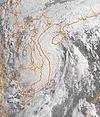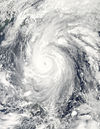Portal:Tropical cyclones
The Tropical Cyclones Portal

A tropical cyclone is a storm system characterized by a large low-pressure center, a closed low-level circulation and a spiral arrangement of numerous thunderstorms that produce strong winds and heavy rainfall. Tropical cyclones feed on the heat released when moist air rises, resulting in condensation of water vapor contained in the moist air. They are fueled by a different heat mechanism than other cyclonic windstorms such as Nor'easters, European windstorms and polar lows, leading to their classification as "warm core" storm systems. Most tropical cyclones originate in the doldrums, approximately ten degrees from the Equator.
The term "tropical" refers to both the geographic origin of these systems, which form almost exclusively in tropical regions of the globe, as well as to their formation in maritime tropical air masses. The term "cyclone" refers to such storms' cyclonic nature, with anticlockwise rotation in the Northern Hemisphere and clockwise rotation in the Southern Hemisphere. Depending on its location and intensity, a tropical cyclone may be referred to by names such as "hurricane", "typhoon", "tropical storm", "cyclonic storm", "tropical depression" or simply "cyclone".
Types of cyclone: 1. A "Typhoon" is a tropical cyclone located in the North-west Pacific Ocean which has the most cyclonic activity and storms occur year-round. 2. A "Hurricane" is also a tropical cyclone located at the North Atlantic Ocean or North-east Pacific Ocean which have an average storm activity and storms typically form between May 15 and November 30. 3. A "Cyclone" is a tropical cyclone that occurs in the South Pacific and Indian Oceans.
Selected named cyclone -
Hurricane Pauline was one of the deadliest Pacific hurricanes to make landfall in Mexico. The sixteenth tropical storm, eighth hurricane, and seventh major hurricane of the 1997 Pacific hurricane season, Pauline developed out of a tropical wave from Africa on September 16, 1997, moving across South America and into the Pacific Ocean. On October 5, the depression intensified into a tropical storm early the next day and by October 7, Pauline had reached hurricane intensity. It initially moved eastward, then turned northwestward and quickly strengthened to reach peak winds of 135 mph (217 km/h). It paralleled the Mexican coastline a short distance offshore before weakening and making landfall near Puerto Ángel, Oaxaca, on October 9, and dissipated the next day.
Hurricane Pauline produced torrential rainfall along the Mexican coastline, peaking at 32.62 inches (829 mm) in Puente Jula. Intense flooding and mudslides in some of the poorest areas of Mexico killed between 230 and 500 people, making it one of the deadliest Eastern Pacific storms in recorded history. The passage of the hurricane destroyed or damaged tens of thousands of houses, leaving around 300,000 people homeless and causing $447.8 million in damage (1997 USD). (Full article...)Selected article -
Subtropical Storm Four brushed Florida and The Bahamas in October 1974. The eighteenth cyclone and fourth subtropical storm of the 1974 Atlantic hurricane season, the storm developed near eastern Cuba on October 4 from an area of disturbed weather. Shortly before striking Andros Island on October 6, the system strengthened into a subtropical storm. The storm made its closest approach to Florida early on October 7. Peaking with sustained winds of 50 mph (85 km/h), the system veered northward and then northeastward, but nonetheless caused heavy rainfall and coastal flooding on land in Florida. While paralleling offshore North Carolina and South Carolina, the storm began to slowly weaken. By late on October 8, the subtropical cyclone merged with a cold front while well east of Cape Hatteras.
Gale-force winds were observed by ships and land stations in The Bahamas. The storm and a stationary high pressure system over the Eastern United States resulted in strong winds and rough seas along the coast of Florida for several days, especially on October 6. Many coastal areas observed sustained winds of 25 to 40 mph (40 to 64 km/h), with higher gusts. The storm also produced isolated pockets of heavy rainfall, including 14 in (360 mm) of precipitation in Boca Raton. Dozens of homes were flooded in Boca Raton and Pompano Beach. The heavy rainfall destroyed about 50% of winter vegetable crops in Broward County and about 25% of the eggplant crop and about 5%-10% of other crops in Palm Beach County. The storm also brought rainfall and abnormally high tides to Georgia, South Carolina, North Carolina, and Bermuda. Damage totaled at least $600,000 (1974 USD). (Full article...)Selected image -

Selected season -

The 2007–08 Australian region cyclone season was a slightly below-average tropical cyclone season. The season began with an early start, with the formation of the first tropical cyclone on 29 July, which was only recognized as a tropical cyclone during post-season analysis. This was the second time that a tropical cyclone had formed during July. The other one was Cyclone Lindsay in the 1996–1997 season. The next tropical cyclone that formed was Cyclone Guba, which formed on 13 November with TCWC Port Moresby assigning the name Guba on 14 November, which was the first named storm within TCWC Port Moresby's area of responsibility since Cyclone Epi in June 2003. Guba was also the first cyclone to occur in the Queensland region in November since 1977.
Tropical Cyclone Lee also formed on 13 November and was named by TCWC Perth on 14 November, with the system moving into RSMC Réunion's area of responsibility and being renamed Ariel. The next Cyclone to form within the Australian region was Melanie, which formed on 27 December and was named on the 28th by TCWC Perth. Melanie was the first storm of the season to require cyclone watches, and warnings were issued for the Pilbara coast, but it had weakened into a low-pressure area before it made landfall. (Full article...)Related portals
Currently active tropical cyclones

Italicized basins are unofficial.
- North Atlantic (2024)
- No active systems
- East and Central Pacific (2024)
- No active systems
- North Indian Ocean (2024)
- No active systems
- Mediterranean (2023–24)
- No active systems
- South-West Indian Ocean (2023–24)
- No active systems
- Australian region (2023–24)
- No active systems
- South Pacific (2023–24)
- No active systems
- South Atlantic (2023–24)
- No active systems
Last updated: 00:02, 23 May 2024 (UTC)
Tropical cyclone anniversaries

- May 24, 1989 - Tropical Storm Cecil (pictured) made landfall in central Vietnam where it killed 52 people and left over 100,000 others homeless.

May 25
- 1985 - A cyclone (pictured) made landfall in Bangladesh and killed 11,069 people.
- 2009 - Cyclone Aila moved ashore Bangladesh, causing 339 fatalities.
- 2018 - Cyclone Mekunu struck southern Oman, causing floods across the Arabian Peninsula, as well as 31 deaths.

May 26
- 1953 - Tropical Storm Alice made landfall in Nicaragua as a minimal tropical storm.
- 2011 - Typhoon Songda (pictured) reaches peak intensity as a Category 5 super typhoon to the northeast of the Philippines. Songda mainly affected Japan, killing 17 people with damages of about ¥23.2 billion (US$287 million).
Did you know…




- …that the Joint Typhoon Warning Center considers that Typhoon Vera (pictured) of 1986 is actually two distinct systems, formed from two separated low-level circulations?
- …that Hurricane Agatha (pictured) was the strongest Pacific hurricane to make landfall in Mexico in May since records began in 1949?
- …that Cyclone Raquel (track pictured) travelled between the Australian and South Pacific basins between the 2014–15 and 2015–16 seasons, spanning both seasons in both basins?
- …that Cyclone Amphan (pictured) in 2020 was the first storm to be classified as a Super Cyclonic Storm in the Bay of Bengal since 1999?
General images -

The 2006 Atlantic hurricane season was a cycle of the annual tropical cyclone season in the Atlantic Ocean in the Northern Hemisphere. The season officially began on June 1, 2006, and ended on November 30, 2006. These dates, adopted by convention, historically describe the period in each year when most subtropical or tropical cyclogenesis occurs in the Atlantic Ocean. The first storm to form in 2006 was Tropical Storm Alberto on June 10; the last, Hurricane Isaac, dissipated on October 2.
The season saw near average activity in terms of the overall number of cyclones. There were ten named storms in the Atlantic basin in 2006, of which five became hurricanes with two intensifying further into major hurricanes. It was the first season since the 2001 season in which no hurricanes made landfall in the United States, and the first since the 1994 season that no tropical cyclones formed during October; activity was slowed by a rapidly forming El Niño event in 2006, the presence of the Saharan Air Layer over the tropical Atlantic, and the steady presence of a robust secondary high-pressure area to the Azores High centered on Bermuda. (Full article...)Topics
Subcategories
Related WikiProjects
WikiProject Tropical cyclones is the central point of coordination for Wikipedia's coverage of tropical cyclones. Feel free to help!
WikiProject Weather is the main center point of coordination for Wikipedia's coverage of meteorology in general, and the parent project of WikiProject Tropical cyclones. Three other branches of WikiProject Weather in particular share significant overlaps with WikiProject Tropical cyclones:
- The Non-tropical storms task force coordinates most of Wikipedia's coverage on extratropical cyclones, which tropical cyclones often transition into near the end of their lifespan.
- The Floods task force takes on the scope of flooding events all over the world, with rainfall from tropical cyclones a significant factor in many of them.
- WikiProject Severe weather documents the effects of extreme weather such as tornadoes, which landfalling tropical cyclones can produce.
Things you can do
 |
Here are some tasks awaiting attention:
|
Wikimedia
The following Wikimedia Foundation sister projects provide more on this subject:
-
Commons
Free media repository -
Wikibooks
Free textbooks and manuals -
Wikidata
Free knowledge base -
Wikinews
Free-content news -
Wikiquote
Collection of quotations -
Wikisource
Free-content library -
Wikiversity
Free learning tools -
Wikivoyage
Free travel guide -
Wiktionary
Dictionary and thesaurus
























































